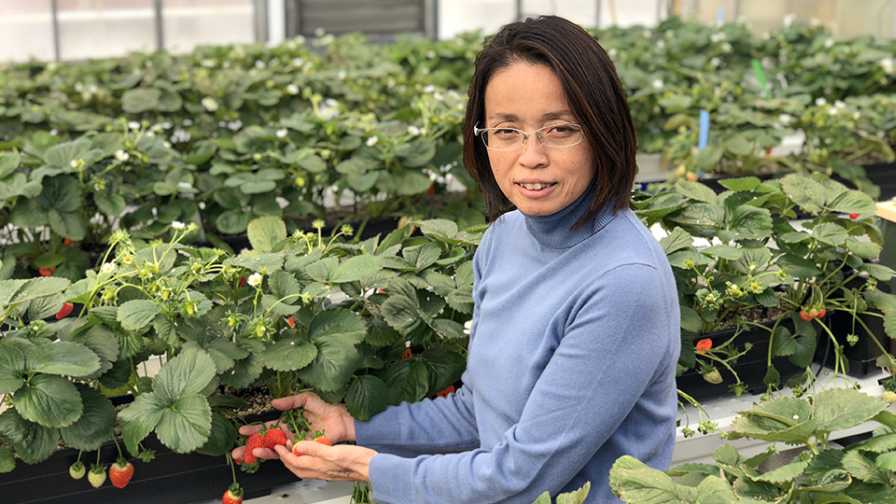Fresh-Market Strawberries Meet Controlled-Environment Growing

Chieri Kubota of The Ohio State University says growers familiar with substrate production of any type of plant shouldn’t have too much difficulty learning to grow strawberries, despite the learning curve. Photo courtesy of The Ohio State University
You can be sure about one thing — there’s a future for greenhouse-grown, fresh-market berries. And while America looks to California, where more than a billion plants are nurtured in open fields and four out of five strawberries grown in the U.S. come from the 400 family-owned berry farms, other parts of the country are waking up to the market potential.
Three Growers Perfect Growing Greenhouse Berries
There’s no better example of that confidence than from Mucci Farms in Ontario, Canada, which started on a 12-acre under-glass site in 2016 and has already tripled that acreage to become one of America’s largest indoor strawberry farms, with growing space equivalent to more than two dozen football fields.
The protected berry patches include grow lights that allow the company to offer quality product year-round. Mucci personnel note: “We’re able to provide plants with perfect temperature and the nutrients and sunlight — along with supplemental LED and high-pressure sodium (HPS) lighting during the winter — meaning less energy needed to fight adverse environmental conditions.”
Elsewhere in Ontario, you’ll find Orangeline Farms [Zing! Healthy Foods and Date Night strawberries], one of the first companies there to grow greenhouse strawberries. Orangeline initially grew product outside in raised gutters under umbrellas when it first started in 2013. It wasn’t long before it moved indoors.
“We took what we knew already from growing crops outdoors and moved indoors, all the while researching varieties and growing habits,” Grower Steve Stasko says. “It required adaptation.”
DelFresco Pure (Kingsville, ON) started growing strawberries as a 1-acre pilot project. After overwhelming success, it expanded to another 10 acres, with production starting in 2017, and its strawberries branded under “YES!Berries Your Everyday Snack!” Another 6-acre expansion, with an HPS lighting system added in, took place in 2019, bringing DelFresco Pure to a total of 17 acres for the 2019 season, and making it one of Ontario’s largest greenhouses with controlled-environment strawberries cultivated under grow lights.
DelFresco Pure berries grow in recycled growing medium in long white gutters set at chest height for easy harvesting. Plants have access to plenty of sun and nutrient-rich water. DelFresco uses an integrated pest management system, which utilizes ladybugs as biological controls, reducing the need for pesticides. It also introduces bumblebees into its greenhouses to pollinate the plants and flowers.
Indoor Niche Crop Potential of Berries a High Likelihood
There’s lots of adaptation going on with the 300 or so growers working on year-round production who belong to the Berry Growers of Ontario Association. General Manager Kevin Schooley represents the strawberry (raspberry and blueberry) growers and says greenhouse growing is still relatively new, responding to a need for year-round product with some large vegetable greenhouses converting to berries.
“Berry fertility is different, watering needs are different, and you need to find suitable day-neutral varieties (‘Albion’ and ‘Monterey’ are popular), so there’s a learning curve, but with our growing expertise, we’re carving out our niche,” he says.
The Quest for Year-Round Production Continues
Industry research continues full force at The Ohio State University in Dr. Chieri Kubota’s Strawberry Lab, where researchers are trying to determine if, like in Europe and Asia, strawberries produced indoors and off-season can find a place in the market.
Kubota arrived in Ohio after doing initial research on hydroponic and soilless strawberry production at the Controlled Environment Agriculture Center in Tucson, AZ.
“The goal of our project was to establish sustainable, off-season hydroponic strawberries in the desert southwest, where there currently is very limited berry production despite a strong greenhouse industry that conducts year-round tomato production,” she says.
At her Ohio lab, Kubota’s greenhouse glass comes in the form of a film covering material called ETFE (ethylene tetrafluoroethylene). She says she sees a growing future for greenhouse-grown product.
“There are so many difficulties in growing strawberries outdoors in places like California — climate changes, water and labor shortages, plant diseases, and then having to ship product across the country for sale,” Kubota says. “It just makes sense to me to work on berries as a potential U.S. greenhouse crop that has already proven itself in greenhouses in Europe, Japan, China, Korea, the Netherlands, and other places.”
Kubota’s successful efforts have relied on production cycles of varieties. ‘Albion’ from University of California Davis has been her preferred standard — “very flavorful,” she says, with acceptable productivity.
Kubota maintains that any grower who has worked with substrate production in any kind of plants in a greenhouse can readily work with strawberries and their need for good root structure, water, and nutrients in a controlled environment.
“Good transplants with quality planting materials are a necessity for greenhouse production, and the U.S. strawberry nursery industry needs to focus on that,” she says. “If we combine off-season greenhouse production with an open-field season and perhaps a high tunnel tabletop effort in between, we can sustainably offer fresh berries in any location in the country year-round. The integration of these capabilities would meet market demand.”
Monitor Demand
If you’re thinking about growing strawberries and statistical data is your thing, consider — Statewide in California, strawberry producers shipped nearly 202 million trays last year, down a bit from 2018 but up from 2017 production.
Last growing season, California berry farmers grew and picked 169.5 million strawberries. This year, weekly production totals statewide could approach 10 million trays by late May. How much of that demand could be filled by a greenhouse-grown crop?










